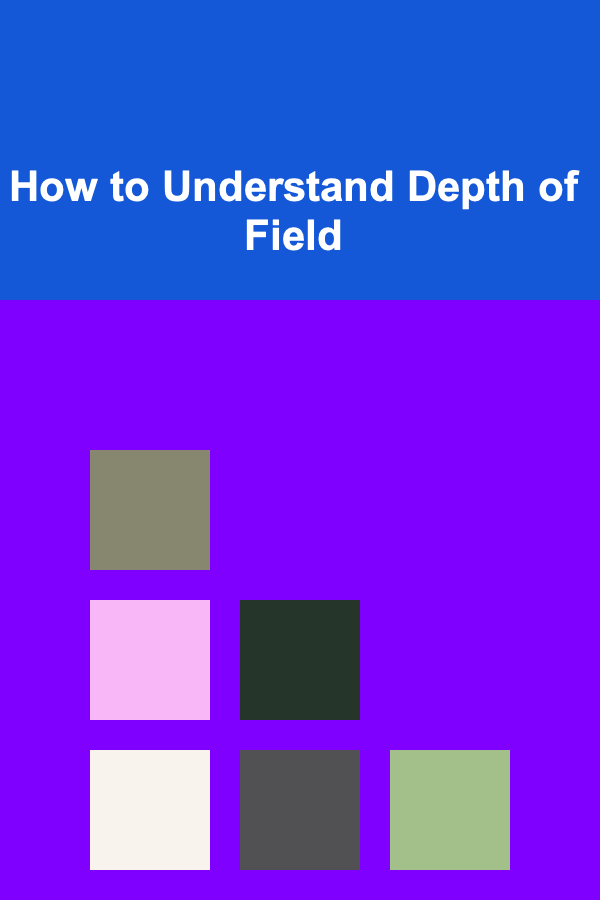
How to Understand Depth of Field
ebook include PDF & Audio bundle (Micro Guide)
$12.99$8.99
Limited Time Offer! Order within the next:

Depth of field (DoF) is a fundamental concept in photography and cinematography that significantly influences the way an image is perceived. It refers to the range of distance within a photograph or a scene that appears acceptably sharp. Depth of field plays a crucial role in creating mood, directing attention, and influencing the storytelling process, especially in visual mediums.
Understanding the mechanics of DoF allows photographers, filmmakers, and visual artists to manipulate focus to achieve their desired effect. This article delves into the principles behind depth of field, the factors that influence it, and how you can use it creatively in your work.
What is Depth of Field?
Depth of field refers to the distance between the nearest and farthest objects in a scene that are in focus. Simply put, it is the zone within the image that appears sharp to the viewer. Anything in front of or behind this zone will appear blurred due to the optical properties of the camera lens. Depth of field is a critical element in composition, determining which parts of the image are emphasized and which are left out of focus.
Shallow vs. Deep Depth of Field
The terms shallow depth of field and deep depth of field are often used to describe the extent of focus in an image.
- Shallow Depth of Field: This is when only a small part of the scene is in focus, and the background or foreground is blurry. Shallow DoF is often used to isolate a subject from the rest of the environment, creating emphasis and visual interest. It is commonly seen in portrait photography, where the subject's face is sharply focused while the background becomes a smooth, blurred bokeh.
- Deep Depth of Field: In contrast, a deep DoF means that a large portion of the scene from the foreground to the background is in focus. This is commonly used in landscape photography or scenes that require the viewer to observe details across the entire frame, such as in architectural photography or street photography.
Factors That Affect Depth of Field
Several key factors influence the depth of field in a photograph or video. These include the aperture setting, the focal length of the lens, the distance to the subject, and the sensor size of the camera. Let's break down each of these factors:
1. Aperture (f-Stop)
The aperture of a camera lens controls the amount of light that enters the camera, and it is a key determinant of depth of field. Aperture is measured in f-stops, such as f/1.4, f/2.8, f/5.6, and so on. The aperture setting is inversely related to the size of the aperture opening---meaning the smaller the f-number, the larger the aperture and the shallower the depth of field.
- Wide Aperture (Small f-number, e.g., f/1.4): A wide aperture allows more light to hit the camera sensor and creates a shallow depth of field. This is useful when you want to emphasize a single subject against a blurry background, such as in portraits.
- Narrow Aperture (Large f-number, e.g., f/16): A narrow aperture reduces the amount of light entering the camera and results in a deeper depth of field, making more of the scene appear in focus. This is ideal for landscape photography or when you want the entire scene to be sharp.
2. Focal Length of the Lens
The focal length of a lens affects how much of a scene is captured and how much of it will appear in focus. Lenses with shorter focal lengths (wide-angle lenses) generally have a larger depth of field, while lenses with longer focal lengths (telephoto lenses) tend to have a shallower depth of field.
- Wide-Angle Lenses (e.g., 24mm): These lenses typically have a wider field of view and tend to produce a deeper depth of field, meaning more of the scene will be in focus. This is beneficial for capturing sweeping landscapes where you want both the foreground and background to be sharp.
- Telephoto Lenses (e.g., 200mm): Longer lenses have a narrower field of view and naturally produce a shallower depth of field. This is advantageous when you want to isolate a subject from the background or compress the distance between objects, creating a more dramatic effect.
3. Distance to the Subject
The closer you are to the subject, the shallower the depth of field will be. Conversely, the farther away you are from the subject, the deeper the depth of field. This is a critical consideration when framing your shot.
- Close-up Subjects: When photographing a subject up close, such as a macro shot of a flower or an insect, the depth of field becomes very shallow. This results in a very small area of the subject being in focus, with the rest of the image appearing blurry.
- Distant Subjects: When photographing a subject that is farther away, the depth of field increases, meaning more of the scene will be in focus. For instance, when photographing a landscape, the large distance between you and the mountains in the background helps ensure a deeper depth of field.
4. Sensor Size
The size of the camera's sensor also influences depth of field. Cameras with larger sensors tend to have a shallower depth of field compared to those with smaller sensors, given the same aperture, focal length, and subject distance. For instance, a full-frame sensor will naturally produce a shallower depth of field compared to a crop sensor, even if both cameras use the same lens and settings.
- Full-Frame Sensors: Cameras with full-frame sensors (35mm sensors) create more pronounced background blur, allowing for a shallower depth of field in portraits or artistic shots.
- Crop Sensors: Cameras with crop sensors, like APS-C or Micro Four Thirds sensors, have a deeper depth of field at the same aperture, focal length, and distance from the subject. This is why crop sensor cameras can sometimes produce sharper images from foreground to background without the need to use a very narrow aperture.
The Circle of Confusion
A key concept in depth of field is the circle of confusion. This refers to the blurred, out-of-focus areas in an image. When a subject is not in focus, the light entering the lens is not converged to a single point on the sensor, creating a blurred circle. The size of this circle determines the degree of blur in the out-of-focus areas, and its size is directly related to the aperture, focal length, and distance from the subject.
The circle of confusion is used to determine how much blur is acceptable in the image. If the circle is large enough, the area will be perceived as out-of-focus by the viewer. The goal in many cases is to achieve a small enough circle that areas of the image not in focus appear smooth and pleasing, as in the case of bokeh.
Practical Applications of Depth of Field
1. Portrait Photography
In portrait photography, depth of field is often used to isolate the subject from the background. By using a wide aperture (e.g., f/1.8 or f/2.8), photographers can create a shallow depth of field, allowing the subject's face to be sharp while the background blurs out, minimizing distractions. This creates a more intimate and flattering portrait.
2. Landscape Photography
For landscape photography, a deep depth of field is usually desired. By using a narrow aperture (e.g., f/11 or f/16), the photographer ensures that both the foreground and the background are in focus, creating a sharp, detailed image. The distance to the subject is also crucial; for landscapes, the photographer often focuses on a point about one-third into the scene to achieve optimal sharpness across the image.
3. Cinematic Storytelling
In film, depth of field is often used creatively to guide the viewer's attention. A shallow depth of field can be used to focus on a character's face, emphasizing emotions or actions, while blurring out the background to avoid distractions. Alternatively, a deep depth of field can be used to show the entire environment and provide context for the action taking place, as seen in wide shots or establishing shots.
Conclusion
Depth of field is a powerful tool that, when understood and utilized correctly, can dramatically enhance the visual impact of a photograph or film. By mastering the various factors that influence DoF---such as aperture, focal length, distance to the subject, and sensor size---you can gain greater control over the narrative and aesthetic of your images. Whether you're a professional photographer, filmmaker, or hobbyist, understanding depth of field will empower you to make more informed and creative decisions in your work.

How to Create a Checklist for Managing Back-to-School Stress for Parents
Read More
How to Create a Holiday Atmosphere with Candles and Lanterns
Read More
How to Make Money Online as a Mechanical Draftsman: 10 Actionable Ideas
Read More
The Healthcare Technician's Toolkit: Tools and Techniques for Success in the Field
Read More
How To Learn Canyoning: Exploring Water-Carved Gorges
Read More
How to Use Natural Elements as Photo Props for Outdoor Photography
Read MoreOther Products

How to Create a Checklist for Managing Back-to-School Stress for Parents
Read More
How to Create a Holiday Atmosphere with Candles and Lanterns
Read More
How to Make Money Online as a Mechanical Draftsman: 10 Actionable Ideas
Read More
The Healthcare Technician's Toolkit: Tools and Techniques for Success in the Field
Read More
How To Learn Canyoning: Exploring Water-Carved Gorges
Read More